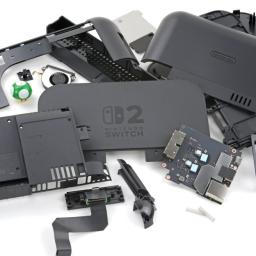 |
by Verge Staff on (#6XV4Z)
Two years ago, we published a list of our favorite summer gear - and it's time to do it again! Things can get a little tense out there in the world, so sometimes you have to pause and take a breath. We're looking forward to taking some time for ourselves by hiking, biking, or hanging [...]
|
The Verge
| Link | https://www.theverge.com/ |
| Feed | http://www.theverge.com/rss/index.xml |
| Updated | 2025-12-24 14:47 |
 |
by Lauren Feiner on (#6XV3M)
For years, protecting kids online has been touted as one of the only issues Republicans and Democrats could agree on. Last year, nearly the entire Senate voted to pass a substantive kids online safety bill in an exceedingly rare show of bipartisanship. Right before the vote to pass the Kids Online Safety Act (KOSA), then-Majority [...]
|
 |
by Sheena Vasani on (#6XV3P)
When OnePlus first introduced its tablet to the world, it impressed with high-end specs at an affordable price. Now, with the OnePlus Pad 3, the company is refining that formula. This latest model brings modest hardware upgrades - including a larger, sharper display, a bigger battery, and an updated smart keyboard - along with meaningful [...]
|
 |
by David Pierce on (#6XV3N)
Hi, friends! Welcome to Installer No. 86, your guide to the best and Verge-iest stuff in the world. (If you're new here, welcome, hope you've cleared your schedule for some Karting this weekend, and also you can read all the old editions at the Installer homepage.) This week, I've been reading about privacy experts and [...]
|
 |
by Tom Warren on (#6XV14)
Something strange is going on with Microsoft's Xbox app on Windows. Over the past few days, the Xbox PC app has started showing Xbox console games inside the library. While you can't install games like the original Alan Wake for Xbox 360, it shows up if you own it as part of the My PC [...]
|
 |
by Tina Nguyen on (#6XTS9)
"I want to make a big announcement," said Faryar Shirzad, the chief policy officer of Coinbase, to a nearly empty room. His words echoed across the massive hall at the Bitcoin Conference, deep in the caverns of The Venetian Expo in Las Vegas, and it wasn't apparent how many people were watching on the livestream. [...]
|
 |
by Andrew Webster on (#6XTSA)
The Wholesome Direct is always full of cute and charming games to keep an eye on for the future. But it's also a great place to find things to play now - and that's especially true this year. The 2025 edition of the livestream showcase included a number of games that released during the show [...]
|
 |
by Tom Regan on (#6XTQS)
When fans nervously tuned in to watch HBO's adaptation of one of their favorite video games, there was one familiar presence that immediately calmed their nerves: the mournful guitar of Gustavo Santaolalla. As certain story beats changed and beloved polygonal faces were replaced with new actors, the beating heart of The Last of Us - [...]
|
 |
by Brandon Widder on (#6XTPD)
This year's WWDC kicks off in less than a week, which means Apple is likely to announce a string of software changes in short order, some of which are designed to improve Apple's latest pair of premium earbuds. Thankfully, if you haven't yet pulled the trigger on the second-gen AirPods Pro, they're once again on [...]
|
 |
by Lauren Feiner on (#6XTPE)
Senate Commerce Republicans have kept a ten year moratorium on state AI laws in their latest version of President Donald Trump's massive budget package. And a growing number of lawmakers and civil society groups warn that its broad language could put consumer protections on the chopping block. Republicans who support the provision, which the House [...]
|
 |
by Lauren Feiner on (#6XTN0)
After the departure of one Republican and one Democratic commissioner on Friday, the Federal Communications Commission is down to two members, falling below the quorum threshold for what's typically a five-person panel. Commissioners Nathan Simington and Geoffrey Starks stepped down at the end of the week. That leaves Republican Chair Brendan Carr and Democratic Commissioner [...]
|
 |
by Allison Johnson on (#6XTN1)
It's early June and the vibes are decidedly off in Cupertino. The hype leading up to Apple's last two developer conferences felt much different. There was anticipation in 2023 for a potentially groundbreaking new headset. In 2024, there was a sense of urgency leading up to the company's AI announcements and whispers that Siri might [...]
|
 |
by Jay Peters on (#6XTJS)
I usually struggle with strategy games. They're typically too hard for me, and I often get overwhelmed at managing multiple characters or squads. But I couldn't put down Teenage Mutant Ninja Turtles: Tactical Takedown, which blends ideas from strategy games and classic TMNT arcade games to keep things snappy, easy to play, and full of [...]
|
 |
by Alex Heath on (#6XTE7)
Battlelines are being drawn between the major AI labs and the popular applications that rely on them. This week, both Anthropic and OpenAI took shots at two leading AI apps: Windsurf, one of the most popular vibe coding tools, and Granola, a buzzy AI app for taking meeting notes. "With less than five days of [...]
|
 |
by Ash Parrish on (#6XTE9)
Now that Summer Game Fest 2025 is off and running, it's time for my favorite part of the show: Day of the Devs. Day of the Devs is a yearly showcase highlighting the newest, quirkiest indie releases, and it is frequently the source of some of my favorite games SGF has on offer. This year [...]
|
 |
by Andrew Webster on (#6XTCZ)
After a very convincing tease that suggested news was in fact not incoming, Capcom just officially announced Resident Evil Requiem, the ninth mainline entry in the franchise. It launches on February 27th, 2026 on PC, PS5, and Xbox. The announcement came via a lengthy trailer that took quite a while before revealing itself to indeed [...]
|
 |
by Ash Parrish on (#6XTD0)
In 1999, the iconic New York rap group Wu-Tang Clan released their very first video game, Wu-Tang: Shaolin Style. Now, 25 years later, the Wu have returned with a new game project called Wu-Tang: Rise of the Deceiver. Announced simultaneously at Summer Game Fest and at the opening performance of the group's farewell tour, Rise [...]
|
 |
by Jay Peters on (#6XTD1)
Yacht Club Games, the studio behind the Shovel Knight series, is launching its next game, Mina the Hollower, on October 31st, the team announced as part of Summer Game Fest on Friday. Mina the Hollower is a top-down adventure game that looks like it was ripped directly from a Game Boy Color. You play as [...]
|
 |
by Andrew Webster on (#6XTB2)
It's that time of year again. With E3 done and gone, Summer Game Fest has taken its place, and it always makes for a busy few days in gaming. The centerpiece of the event is SGF Live on June 6th at 5PM ET, a keynote hosted by Geoff Keighley that, like The Game Awards, is [...]
|
 |
by Jay Peters on (#6XR6X)
After a long wait filled with leaks, reveals, preorder stress, and hands-on events, the Nintendo Switch 2's launch day has finally arrived around the world, including launch events at retailers like Walmart,GameStop,Best Buy, andTarget. Nintendo's next console looks like a worthy successor to the original Switch, and it has a lot of games to play [...]
|
 |
by Jay Peters on (#6XTD2)
Square Enix just announced Killer Inn, a new murder mystery action" game, as part of Summer Game Fest on Friday. In a Killer Inn match, 24 players are divided into two teams of wolves" and lambs," and it's the job of the lambs to discover and kill all the wolves or for the wolves to [...]
|
 |
by Andrew Webster on (#6XTB1)
I'm not sure how it took so long, but a real-time strategy game set in Westeros is finally in the works. The new game is called Game of Thrones: War for Westeros, and it's described as a classic, premium" RTS game for PC that will let players take control of the various houses and factions [...]
|
 |
by Emma Roth on (#6XT8R)
Google is taking another step toward making Gemini a more helpful assistant. It's rolling out scheduled actions," a feature AI Pro and AI Ultra subscribers can use to ask the AI assistant to perform tasks at specific times, like providing a summary of their calendar at the end of each day or generating ideas for [...]
|
 |
by Sheena Vasani on (#6XT8S)
With summer just around the corner, sunglasses make a practical and timely Father's Day gift. If you want to gift a pair that'll truly impress, right now you can buy the latest Ray-Ban Meta Smart Glasses starting at $239.20 (about $61 off) at Amazon, Best Buy, and Target. Beyond just protecting dad's eyes, these stylish [...]
|
 |
by Charles Pulliam-Moore on (#6XT8T)
While you could play Fortnite on the original Nintendo Switch, it was a less than ideal situation that made the game feel more like a rough around the edges tech demo than a polished piece of software. Because of the Switch's hardware limitations, Fortnite could only run at 30 frames per second max, which could [...]
|
 |
by Andrew Liszewski on (#6XT6B)
After retroactively lowering the original Nintendo Switch's repairability score from an 8 out of 10 to just 4 out of 10 to reflect 2025 standards, iFixit has found the Switch 2 to be even harder to fix. Following its full teardown of the new console, iFixit is giving the Switch 2 a 3 out of [...]
|
 |
by Charles Pulliam-Moore on (#6XT6C)
When Mission to Zyxx debuted in 2017, the podcasting space was very different. There were fewer shows, and more money was being spent as companies rushed to figure out how to capitalize on the growing medium. At a time when many big podcasts were focused on news and investigative reporting, Zyxx - an improvised comedy [...]
|
by Jay Peters on (#6XT6D)
Last night, I stayed up way too late playing through the Great Plateau section of The Legend of Zelda: Breath of the Wild - Nintendo Switch 2 Edition, and I'm falling in love with the game all over again. The opening moments of Breath of the Wild are iconic. The wide shot of Hyrule you [...]
 |
by Emma Roth on (#6XT2V)
Apple is planning some significant design changes across its core apps, including Phone, Camera, and Safari, that it will announce at WWDC next week, according to a report from Bloomberg. For its Phone app, Apple will reportedly add a new view that puts favorite contacts, recent calls, and voicemails into a single, scrollable window." Bloomberg [...]
|
 |
by Geoffrey Bunting on (#6XT2W)
Now in its third year, the Access-Ability Summer Showcase is back to redress the lack of meaningful accessibility information across the ongoing video game showcase season. As we see progress broadly slow down, it's also a timely reminder of the good work that's still happening in pursuit of greater accessibility in gaming. "At a time [...]
|
 |
by Cameron Faulkner on (#6XT2Y)
The Nintendo Switch 2 launched on June 5th, and with it, so did a bunch of games. Some are first-party Nintendo titles, though most are third-party offerings, including some notable ports of games we've been enjoying for a while on other gaming platforms. We bundled together all of the Switch 2 accessories in one, easy [...]
|
 |
by Emma Roth on (#6XSZK)
OpenAI says it's forced to store deleted ChatGPT conversations indefinitely" due to a court order issued as part of The New York Times' copyright lawsuit against it. In a post on Thursday, OpenAI chief operating officer Brad Lightcap says the company is appealing the court's decision, which he calls an overreach" that abandons long-standing privacy [...]
|
 |
by Allison Johnson on (#6XSZN)
Oh shit. Did I leave my phone at home? I experienced that moment repeatedly while testing the Samsung Galaxy S25 Edge. I'd glance into my bag, or note the lack of weight in my jacket pocket, and my stomach would drop. The phone isn't there. But lo and behold, after another moment of digging through [...]
|
 |
by Justine Calma on (#6XSZM)
When I first started using Signal, I would connect with friends using our phone numbers. Now, I use Signal to find people to interview for stories, which is why some of my social media posts and articles include a note telling folks how they can reach me on the app. Needless to say, I'd rather [...]
|
 |
by David Pierce on (#6XSZP)
This year's developer conference is coming to a close, but most years the last one is the biggest one: Apple's Worldwide Developer Conference, when the company announces its software plans for the year to come. This year feels different, though. Apple is reportedly planning a redesign that will touch all its operating systems, and a [...]
|
 |
by John B. Kennedy on (#6XSXC)
When you're preparing to move, you can find yourself faced with a lot of paper documents. Holiday cards, leases, letters, tax documents, notes, doodles - whatever - can really stack up over time. If your choices are only "keep" or "trash," it can be hard to let go, even if you choose one of the [...]
|
 |
by Antonio G. Di Benedetto on (#6XSXD)
There is no better way to elevate your living room than by elevating that big TV from a stand and onto a wall. Wall-mounting a TV may seem daunting, but if your space allows it you can reclaim precious real estate on your entertainment center and help your living area feel more open and airy. [...]
|
 |
by Jess Weatherbed on (#6XSTZ)
United Airlines is expanding its in-flight entertainment catalog with audiobooks and video podcasts, courtesy of Spotify. The partnership with Spotify provides passengers with free access to more than 450 hours of curated playlists, audiobooks, and podcasts, including Good Hang with Amy Poehler, The Dave Chang Show, and The Comment Section with Drew Afualo. This content [...]
|
 |
by Jay Peters on (#6XSH5)
Some people reported an unwelcome surprise after picking up their Nintendo Switch 2 preorders at GameStop: staples used to attach receipts to Switch 2 boxes ended up damaging the screens on the console, as reported by IGN. However, GameStop says this was an issue that was isolated" to a single store and that it has [...]
|
 |
by Emma Roth on (#6XSH6)
For the past couple of years, the virtual FediForum conference has offered a glimpse at what's new in the open social web, with last year's big news being Threads' foray into the fediverse. This year's presentation was no different, with several developers showing off new apps that will help to expand the ecosystem of decentralized [...]
|
 |
by Jay Peters on (#6XSH7)
Ahead of the Nintendo Switch 2's launch, Nintendo said that the eShop would be improved and run more smoothly on the new console. Based on our initial testing at The Verge, it's immediately apparent that the Switch 2's eShop is much better. On the original Switch, the eShop can be extremely sluggish. Even just moving [...]
|
 |
by Sheena Vasani on (#6WTW9)
The Switch 2 has finally landed, but it isn't the only hardware Nintendo is launching this week. The company also introduced a range of new accessories for its new gaming console, the bulk of which are now available online at Walmart, Best Buy, GameStop, and Target. From a redesigned Pro Controller to a camera that [...]
|
 |
by Andrew Liszewski on (#6XSE4)
Razer has announced a new Phantom Collection featuring updated versions of four of its accessories designed to enhance a feature the brand is probably best known for: LED accent lighting. The company even sells wireless earbuds that glow, but they're not included in the Phantom Collection which features shells and other components made from translucent [...]
|
 |
by Elizabeth Lopatto on (#6XSE5)
Donald Trump and Elon Musk, two of the most media-addled personalities of our time, are publicly torching their relationship by posting on the public social media networks they each respectively own. I have seen theories that this is kayfabe, and I don't buy it. Trump and Musk have publicly shit-talked people, including each other, before [...]
|
 |
by Andrew J. Hawkins on (#6XSE6)
Wing, the drone company owned by Alphabet, and Walmart are expanding their delivery partnership to five new cities in the US, the companies announced today. Customers who shop at Walmart stores in Atlanta, Charlotte, Houston, Orlando, and Tampa will soon have the ability to request a drone deliver their online shopping orders. Walmart and Wing [...]
|
 |
by Cameron Faulkner on (#6XSAS)
So, you got (or are soon getting) a Nintendo Switch 2. You're probably ready to throw your original Switch into storage, but before that, you should transfer all of your data to the new console. Good news: it's easy for those who have a Switch 2. Not only that, it's easy even if you don't [...]
|
 |
by David Nield on (#6JNH6)
As part of my job as a tech writer, and as part of my ongoing efforts to get organized at some point, I've tested a whole pile of note-taking apps through the years: the simple, the sophisticated, the quirky, the AI-powered, and on it goes. It's a popular app category, and there's no shortage of [...]
|
 |
by Andrew Liszewski on (#6XSAT)
What's Snapchat without the ability to snap and send photos to your friends? It's the social platform's new Apple Watch app that instead provides a quick way to preview messages and reply right from your wrist. Joining mobile and web-based versions of Snapchat, the Apple Watch app lets you preview incoming messages on your wrist [...]
|
 |
by Hayden Field on (#6XSAV)
Anthropic on Thursday announced Claude Gov, its product designed specifically for U.S. defense and intelligence agencies. The AI models have looser guardrails for government use and are trained to better analyze classified information. The company said the models it's announcing are already deployed by agencies at the highest level of U.S. national security," and that [...]
|
 |
by Cameron Faulkner on (#6XSAW)
Depending on where you are in the US, it hasn't been easy to grab a Nintendo Switch 2 (though, our own David Pierce would disagree). In-store and online stock has sold out at most participating retailers, but Target is offering another opportunity, specifically for online shoppers, starting in the early morning" hours of June 6th. [...]
|